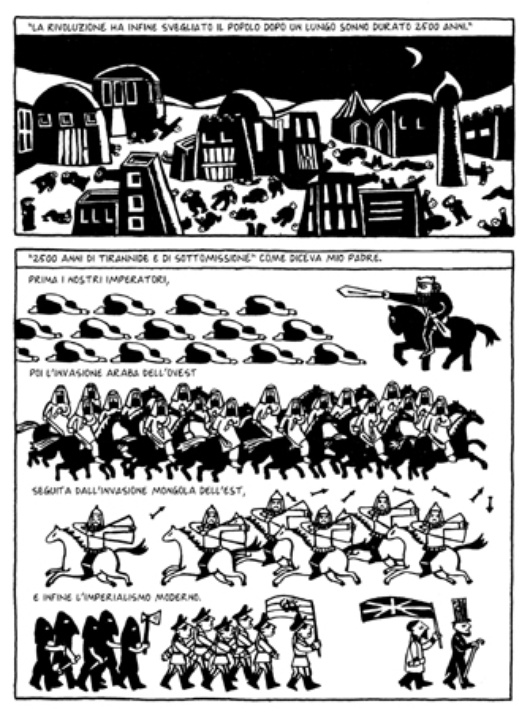Marjane Satrapi
Published on
Time to go ahead with the last part of the long essay on Marjane Satrapi. Here you can read the part one and two; and don't forget the interview with cafebabel! Marjane Satrapi – new literary phenomenon in comics
by Igor Prassel, part three
At this point we will pause on the story of Persepolis.
With an acute sense for the details of daily life and apparently simple narration, Marjane Satrapi tells us about the life of a young girl who is starting to grow up at the time of the beginning of the Iranian Islamic revolution. The story begins immediately after the fall of the Shah and shows us how Marjane (an only daughter) and her family lived during the years of war with Iraq. Marjane was educated in a liberal modern family with an intellectual Marxist father and a feminist mother both
of whom were politically active against the brutal dictatorship. Marji was affected naturally by their struggle of course and became a young revolutionary, sympathising with Castro and Che Guevara and reading texts about Iranian revolutionaries. She followed the struggle for Palestinian liberation and the aggression of the United States in Vietnam…At that time her favourite reading consisted of a comic book entitled “Dialectic Materialism” with Marx and Descartes in the main roles! Listening to the stories of her uncle, her friends and parents, who were tortured in prison, Marji grew up quickly. With the rise of the Islamic fundamentalists to
 power, fear and uncertainty replaced the hope and the sense of new possibilities existing at the beginning of the Islamic Cultural Revolution. Overnight Marjane’s daily life changed drastically. Boys and girls were separated at school, girls had to wear the veil, the cries of the dying are heard more and more (even to the point of massacres such as cinemas being set on fire with the public locked inside…). In the book, Marjane reveals her contempt for Unitarianism right from the first story, “Le Foulard”. Like most Iranians, the Satrapi family too began to look around, to guard their words and way of dress in the period of oppressive conformism that begins to reign in Iran. If that were not enough, war against Iraq broke out causing frequent bombings of Tehran and thousands of Iranians (even thirteen-year-old children) were recruited into the army and sent to the front. In this climate, the now fourteen-year-old Marjane began to rebel (at first by means of the music and western clothes that her parents brought from Turkey and then by verbally challenging the schoolteachers) so her parents decided to send her to Vienna to study and to live with her mother’s best friend. Rediscovering her individual and social liberty Marjane found it difficult to blend in with her peers. The lay consumer society had some ugly surprises for her and at this point the young Marjane began to reclaim her origins. She started by mixing in the alternative scene and through the first true loves gradually finds herself falling into a new existential crisis… When her mother comes to see her in Vienna bringing an “affective baggage” which would help Marjane to overcome even the most unpleasant moments. The roles of her mother and grandmother were very important in Marjane’s life. With the album Broderies, issued this year in the collection Cotelette published by L’Association and dedicated to her grandmother, Marjane broke the taboo and showed us the feminist side of the Iranian woman (three generations of women drinking tea and talking openly about virginity, divorce, love, lovers, arranged marriages, sexuality…). At the time of writing this text I am anxiously awaiting the fourth and last part of Persepolis, which will take Marjane back to Iran at the Academy of Fine Arts and then to her final exile in France… It has been a long time since I have looked forward to reading the end of a story with such impatience and, to tell the truth, I hope that after telling us of half her life Marjane will continue to excite us with her literary comics.
power, fear and uncertainty replaced the hope and the sense of new possibilities existing at the beginning of the Islamic Cultural Revolution. Overnight Marjane’s daily life changed drastically. Boys and girls were separated at school, girls had to wear the veil, the cries of the dying are heard more and more (even to the point of massacres such as cinemas being set on fire with the public locked inside…). In the book, Marjane reveals her contempt for Unitarianism right from the first story, “Le Foulard”. Like most Iranians, the Satrapi family too began to look around, to guard their words and way of dress in the period of oppressive conformism that begins to reign in Iran. If that were not enough, war against Iraq broke out causing frequent bombings of Tehran and thousands of Iranians (even thirteen-year-old children) were recruited into the army and sent to the front. In this climate, the now fourteen-year-old Marjane began to rebel (at first by means of the music and western clothes that her parents brought from Turkey and then by verbally challenging the schoolteachers) so her parents decided to send her to Vienna to study and to live with her mother’s best friend. Rediscovering her individual and social liberty Marjane found it difficult to blend in with her peers. The lay consumer society had some ugly surprises for her and at this point the young Marjane began to reclaim her origins. She started by mixing in the alternative scene and through the first true loves gradually finds herself falling into a new existential crisis… When her mother comes to see her in Vienna bringing an “affective baggage” which would help Marjane to overcome even the most unpleasant moments. The roles of her mother and grandmother were very important in Marjane’s life. With the album Broderies, issued this year in the collection Cotelette published by L’Association and dedicated to her grandmother, Marjane broke the taboo and showed us the feminist side of the Iranian woman (three generations of women drinking tea and talking openly about virginity, divorce, love, lovers, arranged marriages, sexuality…). At the time of writing this text I am anxiously awaiting the fourth and last part of Persepolis, which will take Marjane back to Iran at the Academy of Fine Arts and then to her final exile in France… It has been a long time since I have looked forward to reading the end of a story with such impatience and, to tell the truth, I hope that after telling us of half her life Marjane will continue to excite us with her literary comics.
The end
Credits
"Il velo di Maya o dell'ironia dell'Iran", Elettra Stamboulis e Gianluca Costantini, Mirada cultural association, Ravenna, 2003.
Igor Prassel is member of Stripburger, Slovenian magazine of culture and comics.



